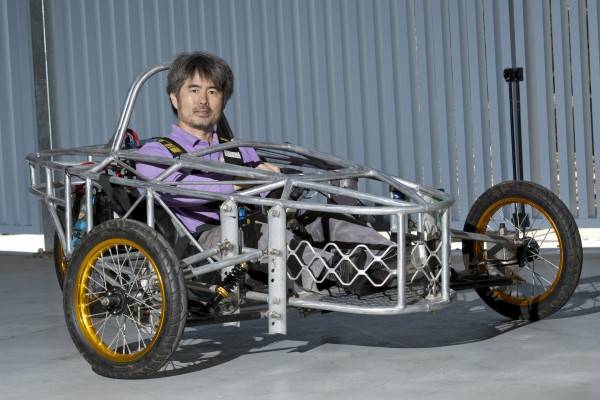Scientists develop fast recharging material for lithium-ion batteries
A group of South Korean scientists has developed a new material for a secondary or rechargeable battery that can be fully recharged in just a matter of minutes. The new battery, on the other hand, uses the same type of nanoparticle materials that are first resolved in a solution that contains graphite, which later is carbonized to form a dense network of conductors all throughout the electrodes of the battery.
As a result, all energy-holding particles of the new battery start recharging simultaneously while the same particles in conventional batteries begin recharging in order from the outermost particles to the innermost. This cuts down on the time needed to recharge the new type of battery to between 1/30 and 1/120 of that of existing rechargeable batteries.
The research team, partly funded by the science ministry, also includes four doctoral students of the Ulsan university -- Lee Sang-han, Cho Yong-hyun, Song Hyun-kon and Lee Kyu-tae. Their paper, titled "Carbon-Coated Single-Crystal LiMn2O4 Nanoparticle Clusters as Cathode Material for High-Energy and High-Power Lithium-Ion Batteries," was published earlier this month in the international edition of the weekly journal Angewandte Chemie.
Bron:
http://english.yonhapnews.co.kr/techscience/2012/08/13/8/0601000000AEN20120813001600320F.HTML
Update: 06-06-2012
 Solar Impulse’s first intercontinental landing
Solar Impulse’s first intercontinental landingTAKE-OFF TIME: 05:22 (UTC+2) 05.06.12
LANDING TIME: 23:30 (UTC+1) 05.06.12
FLIGHT DURATION: 19 H 8 MIN
AVERAGE GROUND SPEED: 51,8 KM/H
HIGHEST ALTITUDE REACHED: 8’229 M (27’000 FT)
FLIGHT DISTANCE: 830 KM
“This flight marks a new stage in the history of the project because we have reached another continent,” added André Borschberg, in consensus with Mr. Bakkoury’s comments “After almost 20 hours of flight we landed with a full set of batteries. This is extraordinary as it represents an increase in confidence in new technologies."
Source:
http://solarimpulse.com/
Datum: 27-04-2012
Liquid batteries to store wind and solar energy
Renewable energies have great potential to solve diminishing natural resources but they are unreliable - if the wind doesn't blow or the sun doesn't shine they simply don't work.
But imagine if the energy that they generate could be stored in a giant battery?
Such a battery would need to be to be low-cost, a problem which has until now prevented such developments.
"In the past battery research has been driven by advanced chemistry that was expensive with the hope that mass production would see the price fall.
"The major difference with my group was that we would only consider components that have a chance of meeting the right price point," said Prof Sadoway.
Source:
http://www.bbc.co.uk/news/technology-17214914
http://lmbcorporation.com/
http://www.thegatesnotes.com/Topics/Energy/We-Need-A-Battery-Miracle
Update: 27-APR-2012
“The way things stand, electricity demand must be in balance with electricity supply.” The problem is: coal and nuclear plants can’t address demand fast enough. How do we deal with the problem of intermittency?
Sadoway thinks he has the answer, and in this hugely well-received talk, he outlines his invention of a liquid metal battery he thinks might act as a blueprint for the future. “If we’re going to get this country out of its current energy situation, we can’t conserve our way out, we can’t drill our way out, we can’t bomb our way out. We’re going to do it the old-fashioned American way: we’re going to invent our way out, working together,” says MIT professor,
Donald Sadoway.
The 36-inch-wide “Bistro Table” battery is not yet ready for prime time, but a future variant is designed to produce the daily electrical needs of 200 American households with a battery that is “silent, emissions free, has no moving parts, is remotely controlled, and is designed to the market price point, without subsidy.”
Datum: 24-Feb-2012
Light management leads to ultra-efficient solar cells, possibly 70%

It has long been thought that conversion efficiency of solar cells cannot exceed 34 percent. A thermodynamic limit is responsible for this practical limitation. By clever light management, however, an efficiency of 70 percent is achievable.
How this can be done is described by AMOLF director Albert Polman and his colleague Harry Atwater from the California Institute of Technology in a commentary article in Nature Materials that appears on Tuesday, February 21.
A solar cell is a device that converts sunlight into electrical power. This conversion process, however, is not very efficient: in a conventional solar cell a large fraction of the energy of the sunlight is lost. Blue and green light are converted to electricity with an efficiency less than 50%, while infrared light is not absorbed by a solar cell at all. The highest efficiency realized by a silicon solar cell is only 27 percent.
Albert Polman: "The solar cell community is very conservative. It is often assumed that only extremely simple solar cells can be made at low costs. But if you can reach an efficiency larger than 50% a much higher cost of the solar cell is acceptable. Solar panels with a high efficiency take up much less space, because you need fewer panels to generate the same amount of power. That saves costs of land, installation and infrastructure. With a slightly more complex solar cell it becomes possible to convert all colors of the light from the sun to electricity. An efficiency of 70% is achievable.
Bron:
http://www.amolf.nl/news/detailpage/article/light-management-leads-to-ultra-efficient-solar-cells//chash/7ece18f9a69a891cddf38b40498927a1/
 Vern Fotheringham is CEO of Kymeta, which was recently spun out of Intellectual Ventures to commercialize a novel satellite antenna that could bring broadband access anywhere on earth, and for considerably cheaper than existing technologies. We caught up with Fotheringham to learn how you get better Wi-Fi on an airplane, what invisibility and connectivity have in common, and why our YouTube videos still frustratingly stall on our smartphones.
Vern Fotheringham is CEO of Kymeta, which was recently spun out of Intellectual Ventures to commercialize a novel satellite antenna that could bring broadband access anywhere on earth, and for considerably cheaper than existing technologies. We caught up with Fotheringham to learn how you get better Wi-Fi on an airplane, what invisibility and connectivity have in common, and why our YouTube videos still frustratingly stall on our smartphones.











